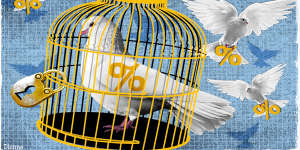Sally Tindall,research director at RateCity,says as property prices fall,more borrowers will find themselves with less bargaining power,and they should look around now for a better deal before it is too late.

Dionne Gain
Economists expect house prices to fall by up to 20 per cent from their peak earlier this year to the end of 2023,leaving more borrowers with less equity in their homes,making it harder to refinance.
Mortgages with the lowest interest rates are generally available to those who have at least 30 per cent equity. The smaller the equity a borrower has,the fewer the lenders likely to offer to refinance the loan – and the less competitive the interest rate.
First home buyers who took advantage of the federal government’s low-deposit scheme – where a deposit of only 5 per cent was required – are among the borrowers most likely to be impacted by falling property prices.
Many may already be in negative equity,where the size of their mortgage is higher than the value of their property.
Borrowers with less than 20 per cent equity which can cost several thousands of dollars. It is amortised into the loan and pushes the repayments – and interest – higher than they otherwise would be.
The insurance is typically non-refundable,which means those with less than 20 per cent equity who switch to another lender would be required to pay the premium again.
Tindall says those with equity of less than 20 per cent and looking for a better rate deal need to weigh up whether the interest savings on a new loan would outweigh the cost of new lenders mortgage insurance.
Existing borrowers continue to pay a “loyalty tax”,as lenders often charge new mortgage customers less interest.
RateCity figures show someone who took out a mortgage in late 2019 at the lowest average big-four bank rate would be paying 0.89 percentage points more than a new customer today.
“Have a look at what your bank is offering new customers,but also what other lenders will offer you. If it’s lower,pick up the phone and ask the bank to cut your rate,” Tindall says.
The most competitive rates for owner-occupiers start with a 3,and those borrowers with a 4 or even a 5 should be questioning why they are paying so much,she says.
Some lenders have not yet revealed if they intend to pass on some,or all,of the Reserve Bank of Australia’s (RBA) official August rate rise. That means there is a danger that someone could refinance to a seemingly competitive variable rate,only to see the lender quickly increase that rate.
RateCity figures show that among lenders who have acted on the August increase,the best variable rates available for those with deposits of 20 per cent or more are Bank of us,at 3.29 per cent,and P&N Bank and G&C Mutual,each at 3.34 per cent.
The RBA is expected to keep increasing the cash rate,which is usually passed on in full by lenders to their variable-rate mortgage customers.
The central bank has increased the cash rate at each of its monthly meetings since May,from 0.1 per cent to 1.85 per cent. The past three increases were 0.5 percentage points each,as it seeks to curb fast-rising inflation.
Economists expect another 0.5 per cent point rise in September,with the cash rate peaking towards the end of this year or the start of 2023,at between 2.5 per cent and 3.5 per cent.